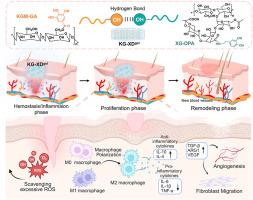天然来源的生物胶粘剂水凝胶具有双重抗氧化和免疫调节特性,促进血管生成和伤口愈合
IF 18
1区 医学
Q1 ENGINEERING, BIOMEDICAL
引用次数: 0
摘要
持续的炎症反应和氧化损伤严重损害了有效的伤口修复,它们共同阻碍了组织再生并加剧了纤维化瘢痕。为了克服这些双重障碍,我们设计了一个多功能水凝胶平台,命名为KGM-GA/XG-DPA (KG-XDgel),通过将没食子酸偶联的魔芋葡甘露聚糖(KGM-GA)与多巴胺修饰的黄原胶(XG-DPA)分子整合。这种生物材料系统具有双重治疗模式:(1)通过酚类成分(没食子酸和儿茶酚部分)的协同氧化还原活性同时清除活性氧(ROS);(2)通过碳水化合物介导的CD206受体参与靶向免疫调节,驱动M2巨噬细胞极化。由于多巴胺驱动的组织粘附和自愈特性,水凝胶在生理应激下保持结构完整性。在小鼠全层伤口模型中,KG-XDgel治疗在7天内实现了令人印象深刻的81%的上皮闭合,同时在第14天CD31+新生血管网络上调8.7倍。值得注意的是,这些治疗结果是通过内源性生物激活而不是外源性生长因子或药物来实现的。通过将抗氧化防御与先天免疫重编程融合在一个单一的生物材料平台上,KG-XDgel为加速伤口再生建立了一种新的无药范式,在临床伤口管理中显示出显著的转化潜力。本文章由计算机程序翻译,如有差异,请以英文原文为准。

Natural-origin bioadhesive hydrogel with dual antioxidative and immunoregulatory properties for enhanced angiogenesis and wound healing
Effective wound repair is critically impaired by persistent inflammatory responses and oxidative damage, which collectively impede tissue regeneration and exacerbate fibrotic scarring. To overcome these dual barriers, we engineered a multifunctional hydrogel platform, designated KGM-GA/XG-DPA (KG-XDgel), through molecular integration of gallic acid-conjugated konjac glucomannan (KGM-GA) with dopamine-modified xanthan gum (XG-DPA). This biomaterial system demonstrates dual therapeutic modalities: (1) concurrent scavenging of reactive oxygen species (ROS) via synergistic redox activity from phenolic components (gallic acid and catechol moieties), and (2) targeted immunomodulation through carbohydrate-mediated engagement of CD206 receptors to drive M2 macrophage polarization. Enhanced by dopamine-driven tissue adhesion and self-healing properties, the hydrogel maintains structural integrity under physiological stress. In murine full-thickness wound models, KG-XDgel treatment achieved an impressive 81 % epithelial closure within 7 days, accompanied by an 8.7-fold upregulation of CD31+ neovascular networks by day 14. Notably, these therapeutic outcomes were accomplished through endogenous biological activation rather than exogenous growth factors or pharmacological agents. By converging antioxidant defense with innate immune reprogramming in a single biomaterial platform, KG-XDgel establishes a novel drug-free paradigm for accelerated wound regeneration, demonstrating significant translational potential in clinical wound management.
求助全文
通过发布文献求助,成功后即可免费获取论文全文。
去求助
来源期刊

Bioactive Materials
Biochemistry, Genetics and Molecular Biology-Biotechnology
CiteScore
28.00
自引率
6.30%
发文量
436
审稿时长
20 days
期刊介绍:
Bioactive Materials is a peer-reviewed research publication that focuses on advancements in bioactive materials. The journal accepts research papers, reviews, and rapid communications in the field of next-generation biomaterials that interact with cells, tissues, and organs in various living organisms.
The primary goal of Bioactive Materials is to promote the science and engineering of biomaterials that exhibit adaptiveness to the biological environment. These materials are specifically designed to stimulate or direct appropriate cell and tissue responses or regulate interactions with microorganisms.
The journal covers a wide range of bioactive materials, including those that are engineered or designed in terms of their physical form (e.g. particulate, fiber), topology (e.g. porosity, surface roughness), or dimensions (ranging from macro to nano-scales). Contributions are sought from the following categories of bioactive materials:
Bioactive metals and alloys
Bioactive inorganics: ceramics, glasses, and carbon-based materials
Bioactive polymers and gels
Bioactive materials derived from natural sources
Bioactive composites
These materials find applications in human and veterinary medicine, such as implants, tissue engineering scaffolds, cell/drug/gene carriers, as well as imaging and sensing devices.
 求助内容:
求助内容: 应助结果提醒方式:
应助结果提醒方式:


